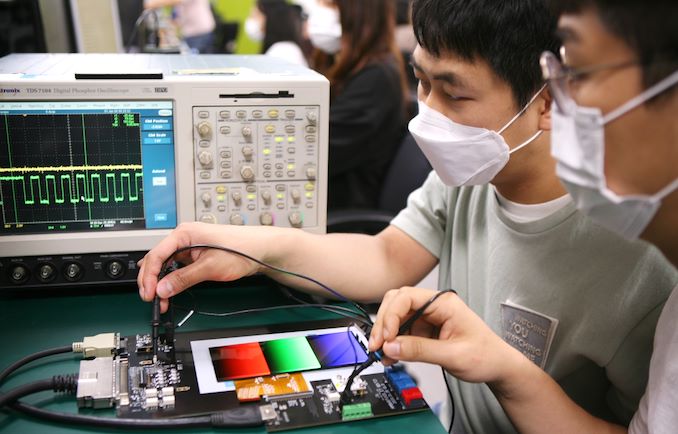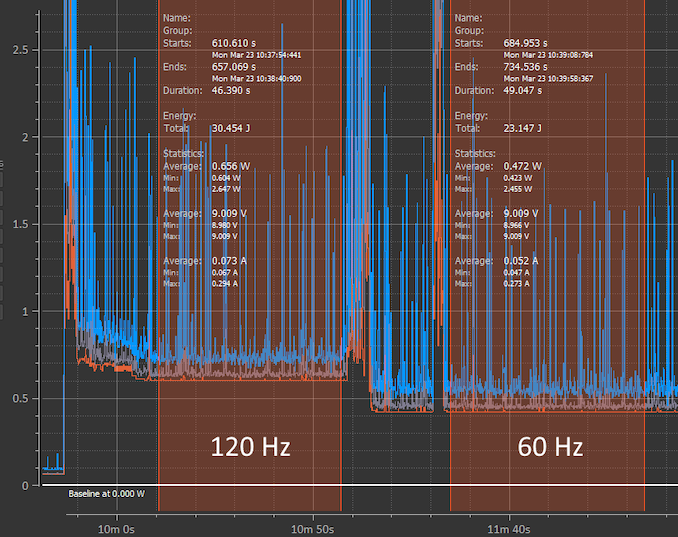Samsung Display Announces First VRR Mobile Display - Inside Note20 Ultra
by Andrei Frumusanu on August 11, 2020 7:00 PM EST
By now we’ve become quite familiar with high refresh-rate displays in the mobile space, as the first pioneering 90Hz devices last year have now evolved into even faster refreshing 120Hz smartphones becoming the standard. Although all these devices provide augmented user experiences by providing extra smooth scrolling and gaming experiences, they all come with notable compromises when it comes to power efficiency and battery life.
Today, Samsung Display is announcing that they are for the first time revealing new generation display panels that allow for variable refresh rate technology, alleviating one of the biggest draw-backs of current generation high-refresh-rate smartphones. The new technology is makings its debut in the new Galaxy Note20 Ultra, which should be available to the public in just two short weeks.
Currently, the biggest issue for devices using a high refresh rate display is the fact that all current implementation still functions at a certain fixed refresh rate no matter what the screen content is, meaning they always stick to either 60, 90 or 120Hz depending on the smartphone.
This year’s smartphones with 120Hz display in particular have seen the effect of drastically increased power draw when operating under this higher refresh-rate. Although these phones offer the ability to switch between different refresh rates, one cannot call these mechanisms variable refresh rate (VRR) displays as they cannot seamlessly and quickly switch between these modes. As such, even when you’re displaying a fixed static screen, the display continues to refresh at 120Hz and incurs a large power draw penalty, which is less than ideal.
Samsung’s new display panel employed in the new Note20 Ultra is actually described as a VRR panel, with Samsung promising new refresh rate modes such as the ability to operate at 120, 60, 30 and 10Hz modes. The latter super-low refresh rates have been to date never been used in smartphones. Samsung describes that the display will now be able to lower itself down to this new 10Hz mode when viewing static content.
"Existing smartphone panels offer only a fixed refresh rate. They cannot automatically calibrate a phone’s refresh rate, which would result in image flickering caused by luminance differences at lower refresh rates. Samsung Display’s new backplane** technology eliminates flickering for operating frequencies as low as 10Hz."
Samsung describes the usage of a new backplane technology in order to achieve this – whilst we haven’t had an official response from Samsung to our questions on the matter, there’s been rumours that this is the generation in which the company has introduced LTPO backplane technology, allowing it higher switching performance and lower power consumption.
Another question which remains to be answered is exact details on Samsung’s VRR workings, and whether it is a proper implementation of adaptive sync technology and if it has finer refresh rate granularity in the 10-120Hz beyond just the mentioned 60 and 30Hz examples.
Currently such a VRR implementation would also require a deeper software stack integration into the OS, GPU driver and display driver to fully enable it a seamless operation that would work transparently on any kind of static or low-framerate content – we’ll have to investigate this topic more once Note20 Ultra devices are officially out.
Samsung claims that the new technology should be able to reduce the phone’s display panel power usage by 22% in general use. Furthermore, there’s a statement of it only using 60% of the power of current screens when it is operating in super-low 10Hz mode – although both these figures don’t specify to which baseline they’re being compared to (60 or 120Hz displays?).
Update: Samsung clarified that 10Hz operates at 40% power of 120Hz baseline, thus reducing power by 60%. Seemingly The 60% power figure is comprared to 60Hz baseline.
Beyond making 120Hz a viable option for daily usage without major battery impact, the new technology should have the potential to improve power efficiency even beyond current 60Hz displays, which hopefully would usher in notably increased battery life in upcoming next-gen devices.











30 Comments
View All Comments
erinadreno - Tuesday, August 11, 2020 - link
Funny that their channel 1 of oscilloscope doesn't actually contain any signal. Probably for photography only, but still interesting.damianrobertjones - Wednesday, August 12, 2020 - link
They're probably looking at the screen in front of them.brucethemoose - Wednesday, August 12, 2020 - link
Andrei, if you ever get around to testing this display, could you give 24p and 30p videos a try on the MPV Android app?If you go into the settings and enable the lua stats and display-resample options, MPV will display info such as the detected display refresh rate, vsync jitter and more while a video is playing.
I'm sure to be in a tiny minority, but butter-smooth 24p video playback is one of my favorite things about having a 120hz phone, and I'm curious to see if Samsung included a native 24p mode.
rynomuncher - Wednesday, August 12, 2020 - link
Great job guys! Now please give us the full resolution while at the higher refresh!alufan - Wednesday, August 12, 2020 - link
I personally cannot see why this has taken so long to come out my S20 Ultra will do 120mhz, its just a software switch in settings so why cant apps have the option to switch it on and off as the need arises eg games run at 120 and photos camera etc but all other stuff like menus or browsing default to the lower valueMarcusMo - Wednesday, August 12, 2020 - link
120Hz, not MHz, M stands for Mega as in one million hertz.VRR lets applications change the required refresh rate on the fly. For instance a web browser could render content at a very low refresh rate (10hz) to save battery, and when the user starts to scroll it switches to 120hz to provide smooth input with low latency.
For this to work the switching of refresh rates need to be nearly instant, and to really save battery the lower end refresh rate needs to be low as possible. I’m not sure how the os wide toggle you’re talking about is implemented, and maybe someone here can enlighten us, but it is undoubtedly slow to switch rates and its lower bound refresh rate is probably 60Hz.
alufan - Wednesday, August 12, 2020 - link
Doh MHZ!the change in menu is under display and its instant dunno if the screen is default at 120 and is reduced to 60 to save power but surely there must be an ability to get the power settings to switch it when in phone menu etc
edzieba - Wednesday, August 12, 2020 - link
We've gone full circle! The Panel Self Refresh spec intended for mobile device power reduction was modified to become VRR, now VRR has been extended to mobile devices to reduce power consumption!Spunjji - Wednesday, August 12, 2020 - link
Glad to see this finally arriving, although it sounds like it's not quite the full package yet!s.yu - Friday, August 14, 2020 - link
IIRC IGZO already had this?